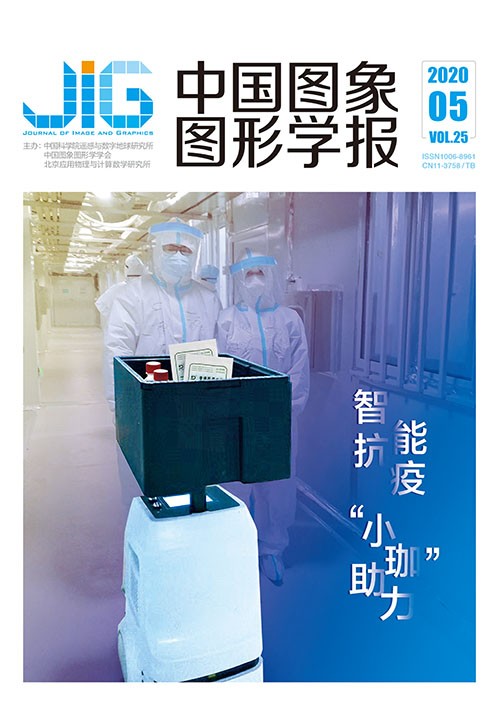
密集网络图像哈希检索
摘 要
目的 为提取可充分表达图像语义信息的图像特征,减少哈希检索中的投影误差,并生成更紧致的二值哈希码,提出一种基于密集网络和改进的监督核哈希方法。方法 用训练优化好的密集网络提取图像的高层语义特征;先对提取到的图像特征进行核主成分分析投影,充分挖掘图像特征中隐含的非线性信息,以减少投影误差,再利用监督核哈希方法对图像特征进行监督学习,将特征映射到汉明空间,生成更紧致的二值哈希码。结果 为验证提出方法的有效性、可拓展性以及高效性,在Paris6K和LUNA16(lung nodule analysis 16)数据集上与其他6种常用哈希方法相比,所提方法在不同哈希码长下的平均检索精度均较高,且在哈希码长为64 bit时,平均检索精度达到最高,分别为89.2%和92.9%;与基于卷积神经网络的哈希算法(convolution neural network Hashing,CNNH)方法相比,所提方法的时间复杂度有所降低。结论 提出一种基于密集网络和改进的监督核哈希方法,提高了图像特征的表达能力和投影精度,具有较好的检索性能和较低的时间复杂度;且所提方法的可拓展性也较好,不仅能够有效应用到彩色图像检索领域,也可以应用在医学灰度图像检索领域。
关键词
Image Hash retrieval with DenseNet
Wang Yage, Kang Xiaodong, Guo Jun, Li bo, Zhang Huali, Liu Hanqing(School of Medical Imaging, Tianjin Medical University, Tianjin 300203, China) Abstract
Objective To extract image features that can fully express image semantic information, reduce projection errors in Hash retrieval, and generate more compact binary Hash codes, a method based on dense network and improved supervised Hashing with kernels is proposed. Method The pre-processed image data set is used to train the dense network. To reduce the over-fitting phenomenon, L2 regularization term is added into the cross entropy as a new loss function. When the dense network model is training, batch normalization (BN) algorithm and root mean square prop (RMSProp) optimization algorithm are used to improve the accuracy and robustness of the model. High-level semantic features of images with trained and optimized dense network model are removed to enhance the ability of image features to express image information and build an image feature library of the image dataset. The kernel principal component analysis projection is then performed on the extracted image features. The nonlinear information implicit in the image features is fully exploited to reduce the projection error. The supervised kernel Hash method is also used to supervise the image features, enhance the resolution of the linear inseparable image feature data, and map the features to the Hamming space. According to the correspondence between the inner product of Hash code and Hamming distance and the semantic similarity monitoring matrix composed of image label information, the Hamming distance is optimized to generate a more compact binary Hash code. Next, the image feature Hash code library of the image dataset is constructed. Finally, the same operation is performed on the input query image to obtain the Hash code of the query image. The Hamming distance between the Hash code of the query image and the Hash code of the image feature in the image dataset is compared to measure the similarity. The retrieved similar images are returned in ascending order. Result To verify the effectiveness, expansion, and efficiency of the proposed method, our method is used respectively in Paris6K and lung nodule analysis 16(LUNA16) datasets. It is also compared with other six commonly used Hashing methods. The average retrieval accuracy is compared in 12, 24, 32, 48, 64, and 128 bits of code length. Experimental results show that the average retrieval accuracy increases with the increase of Hash code length. When the Hash code length increases to a certain value, the average retrieval accuracy decreases. The average retrieval accuracy of the proposed method is always higher than that of the other six Hash methods. Except for the semantic Hashing method, the average retrieval accuracy value reaches the maximum when the Hash code length is 48 bits. Other Hash methods, including the proposed method, have the maximum average retrieval accuracy value when the Hash code length is 64 bits, and the retrieval accuracy is better. When the Hash code length is 64 bits, the average retrieval accuracy value of the proposed method is as high as 89.2% and 92.9% in the Paris6K and LUNA16 datasets, respectively. The time complexity of the proposed method and the convolutional neural network (CNN) Hashing method is compared in the Paris6K and LUNA16 data sets when the Hash code length is 12, 24, 32, 48, 64, and 128 bits. Results show that the time complexity of the proposed method is reduced under different Hash code lengths and is efficient to a certain degree. Conclusion A method based on dense network and improved supervised Hashing with kernels is proposed. This method improves the expression ability of image features and projection accuracy and is superior to other similar methods in average retrieval accuracy, recall rate, and precision rate. It improves the retrieval performance to some extent. It has a lower time complexity of algorithm than the method of CNN Hashing method. In addition, the proposed method has better extensibility, which can be used not only in the field of color image retrieval but also in the field of medical gray scale image retrieval.
Keywords
dense convolutional network(DenseNet) supervised Hashing with Kernels image features projection error kernel principal component analysis(KPCA)
|



 中国图象图形学报 │ 京ICP备05080539号-4 │ 本系统由
中国图象图形学报 │ 京ICP备05080539号-4 │ 本系统由